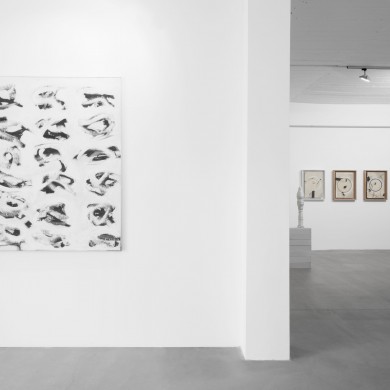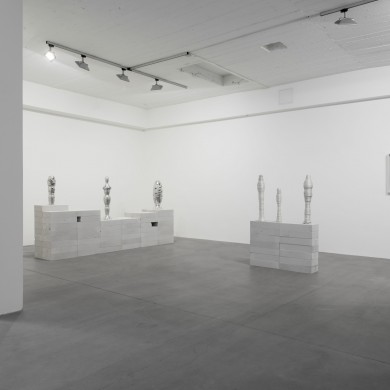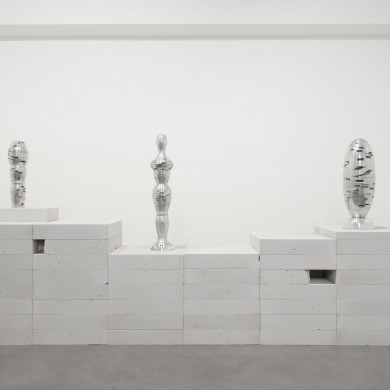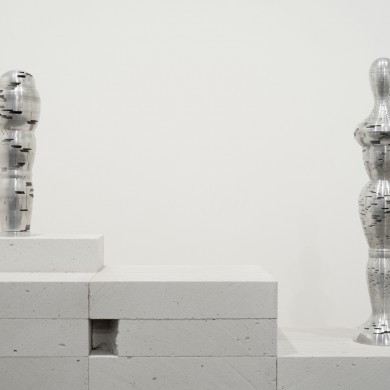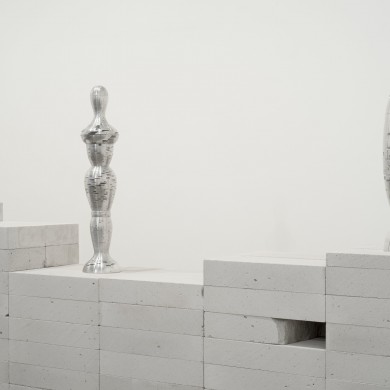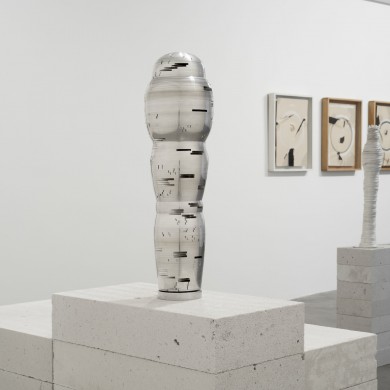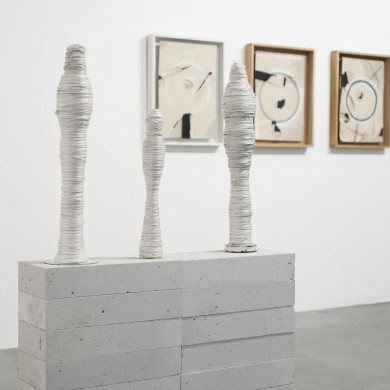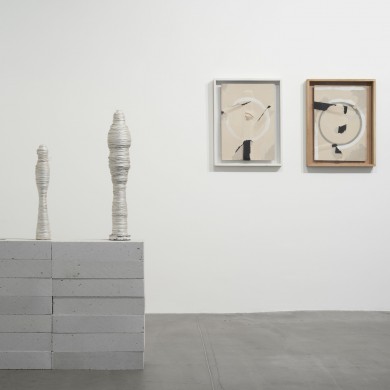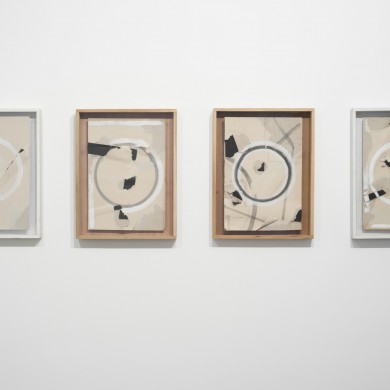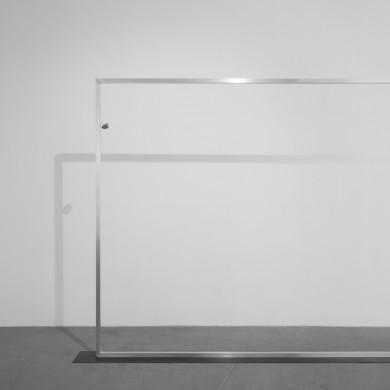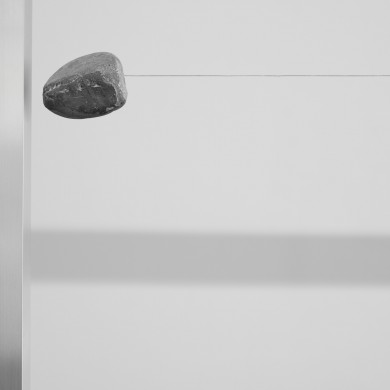JURAJ BARTUSZ – PROCESS
Guest and Architecture of the Exhibition: Jaroslav Kyša
curator: Silvia Van Espen
6 April – 25 May 2017
ZAHORIAN & VAN ESPEN Bratislava
Juraj Bartusz (1933), sculptor and intermedia artist, is one of the most potent representatives of the older generation of artists. His work is among the peak achievements in the history of Slovak visual art, while having outgrown the purely Slovak context. Juraj Bartusz’s sculptures are securely part of the Slovak artistic canon for the second half of the 20th century. Today his achievement is beyond question and has become a subject of research for many respected art historians. His artistic production has clearly defined frames of interpretation, being already mapped and categorised in art-historical terms.
Juraj Bartusz entered the Slovak art scene in the late 1960s as a constructivist, a representative of minimalism, and a member of the Concretists’ Club. In the course of the later 20th century his artistic enterprise underwent various modifications, mirroring his identity as a researcher and a seeker. Bartusz was able to move with supreme assurance between what were often contradictory art tendencies: from the cold rationality of constructivism to the energetic irrationality of abstract expressionism; from dematerialised works to technologically and professionally demanding monumental sculptures realised in public space; from performative to static works; from the administrative aesthetics of conceptualism to the wild transavantgarde. There was a notable balancing in his sculptural activity, which was evident also in the intensity and impact of his expression: dynamism alternated with contemplation, the industrial changed places with the sacral and the organic likewise with the inorganic. Equally, the time orientation of the themes addressed is very difficult to reduce to order: present, future (Cosmonauts, 1969 – 1974), and past (On the Way, 1997, collaboration with I. Németh). However, it is essential to add that diverse positions and oppositional fields have been synthesised many times in his work: rationality, as it were, has “stratified” irrationality.
Movement, change, breakthrough and transformation have been present in his work not only in terms of artistic trends and strategies employed but also in his media: sculpture, monument, object, action, living sculpture, computer, painting, drawing, installation, etc. This self-assured crossing between media has made him the intermedia neo-avantgardist par excellence and has contextualised his work in a European framework. A sensitive reference to actual lived socio-political experience appeared in his work simultaneously with reflection on the medium and a questioning of its limits: static painting thus swallows the element of time (Time limit I, 1987), a sculpture is modelled independently of the artist’s intention by a computer (Spacetime Head , 1976), plaster is a recorder of gesture in time (Brick Thrown into Setting Plaster, 1980), and processuality is an integral part of the sculptural artefact (Spacetime Sculpture, 1976 – 1978). The last-mentioned characteristic, processuality, is precisely what forms the foundation of Bartusz’s lifelong effort. In the concept of the exhibition in ZAHORIAN & VAN ESPEN temporality, process and activity are emphasised in relation to the sculptural work. Further accentuating this is the structural level of the exhibition, created by Jaroslav Kyša. The plinths of the works presented consist of industrially manufactured bricks. Before each opening of the gallery, however, the bricks are randomly shifted; they are therefore in movement. The plinths do not only fulfil the function of “raising the artefact”: they also perform the role of “supporting the significance” of Bartusz’s work.
Guest of the exhibition is Jaroslav Kyša (1981), who graduated from the Technical University in Košice (Art Faculty) in Juraj Bartusz’s Studio of Free Creativity in 3D (2000-2007). His participation at the exhibition with David (2016) indicates the lasting cross-generation message of artistic authority towards the young generation. Kyša thus follows his teacher in preserving his inclination towards process, wide intermedia coverage and sensitivity towards the socio-political situation. Kyša in his presented art work opens the mythology story of David and Goliath while reflecting the current social situation. / Erik Vilím
Sochár a intermediálny umelec Juraj Bartusz (1933) je jeden z najsilnejších predstaviteľov staršej generácie, je to autor, ktorého dielo patrí medzi vrcholy dejín slovenského výtvarného umenia, pričom presahuje čisto slovenský kontext. Sochárske práce Juraja Bartusza sú pevnou súčasťou kánonu slovenského výtvarného umenia druhej polovice 20. storočia. Bartuszov umelecký prínos je dnes už nespochybniteľný, stal sa predmetom výskumu mnohých autorít kunsthistorickej obce. Jeho umelecká produkcia má už jasne vytýčené interpretačné mantinely, je zmapovaná a kunsthistoricky kategorizovaná.
Juraj Bartusz vstúpil na slovenskú umeleckú scénu už koncom 60. rokov 20. storočia ako konštruktivista, predstaviteľ minimalizmu a člen Klubu konkretistov. V priebehu druhej polovice 20. storočia jeho umelecké ťaženie prechádzalo rôznymi modifikáciami, ktoré odzrkadľovali jeho identitu výskumníka a hľadača. Bartuszovi sa podarilo suverénne pohybovať medzi častokrát protikladnými umeleckými tendenciami: od chladnej racionality konštruktivizmu k energickej iracionalite abstraktného expresionizmu; od dematerializovaných diel k technologicky a remeselne náročným sochárskym monumentálnym realizáciám vo verejnom priestore, od performatívnych prác k statickým; od administratívnej estetiky konceptualizmu k divokej transavantgarde. Balansovanie bolo v jeho sochárskej aktivite zreteľné aj v intenzite či pôsobnosti jeho umeleckého výrazu: dynamickosť strieda konteplatívnosť, industriálnosť obmieňa sakrálnosť, organickosť zas anorganickosť. Rovnako tak časová orientácia spracovávaných tém je len veľmi ťažko redukovateľná: prítomnosť, budúcnosť (Kozmonauti [1969 - 1974]), minulosť (Cestou [1997][spolupráca s I. Németh]). Je však nutné dodať, že rôznorodé polohy a opozitné póly boli mnohokrát v jeho produkcii syntetizované: racionalita akoby „vrstvila“ iracionalitu.
Pohyb, zmena, prelom či transformácia v jeho diele nebola prítomná len na úrovni umeleckých smerov a využitých stratégii, ale aj na úrovni médií: socha, monument, objekt, akcia, živá plastika, počítač, maľba, kresba, inštalácia, atď. Toto sebavedomé prestupovanie medzi médiami z neho urobilo intermediálneho neoavantgardistu par excellence a kontextualizovalo jeho tvorbu do európskeho rámca. Citlivá referencia k aktuálnym žitým socio-politickým skutočnostiam sa v jeho práci objavovala simultánne s reflexiou média, so spochybňovaním jeho limitov: statická maľba tak pohlcuje element času (Časový limit I, 1987), socha je modelovaná mimo intenciu autora počítačom (Časopriestorová hlava, 1976), sadra je záznamom gesta v čase (Tehla hodená do tuhnúcej sadry, 1980), procesualita je integrálnou súčasťou sochárskeho artefaktu (Časopriestorová plastika, 1976 – 1978). Práve posledná zmieňovaná charakteristika, procesuálnosť, tvorí esenciálny základ Bartuszovho celoživotného umeleckého snaženia. Koncepcia výstavy v ZAHORIAN & VAN ESPEN galérii zdôrazňuje časovosť, proces a aktivitu vo vzťahu k sochárskemu dielu. Na tomto akcente sa podieľa aj architektonická rovina výstavy, ktorej autorom je Jaroslav Kyša. Podstavce prezentovaných diel pozostávajú z industriálne vyrábaných tehál. Tehly sa však pred každým otvorením galérie náhodne presúvajú, sú teda v pohybe. Podstavcom tak nenáleží len funkcia efektu, „povýšenia artefaktu“, ale plnia aj úlohu „významovej podpory“ Bartuszovho diela.
Hosťom výstavy je Jaroslav Kyša (1981), ktorý absolvoval štúdium na Technickej univerzite v Košiciach (Fakulte umení) v Ateliéri slobodnej kreativity 3D Juraja Bartusza (2000-2007). Jeho participovanie na výstave dielom David (2017) ukazuje pretrvávajúci medzigeneračný odkaz umeleckej autority u mladej generácie. Kyša si tak po vzore svojho učiteľa v tvorbe zachováva inklináciu k procesualite, široký intermediálny záber a citlivosť voči sociálno-politickému dianiu. V prezentovanej práci Kyša využíva proces schnutia ako súčasť umeleckého vyjadrenia, pričom akcentuje symbolickú rovinu materiálu. Kyša tu otvára univerzálnu tému vzťahu medzi ženou a mužom. / Erik Vilím
Realizované s finančnou podporou![]()
